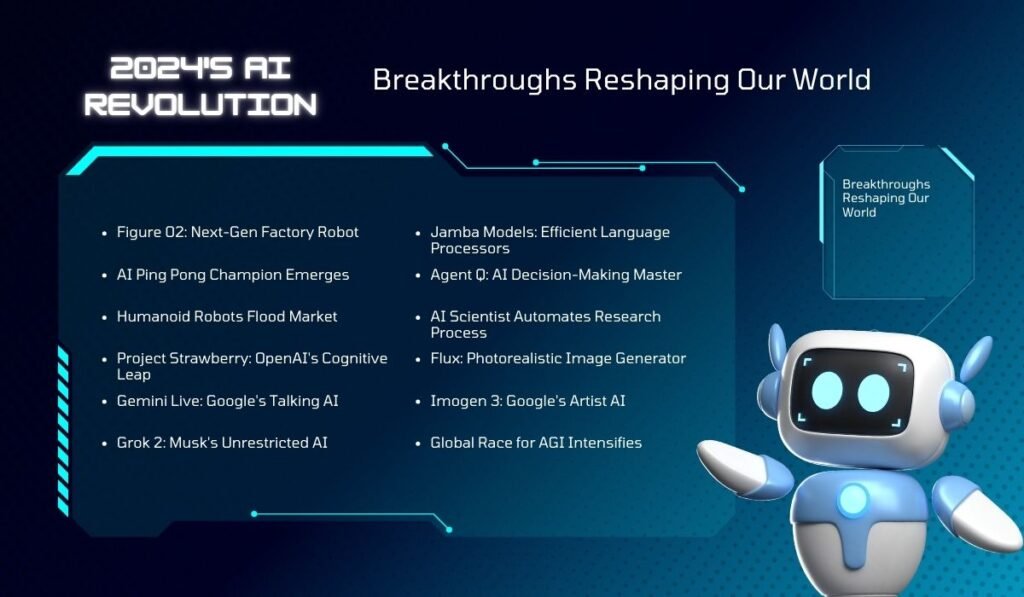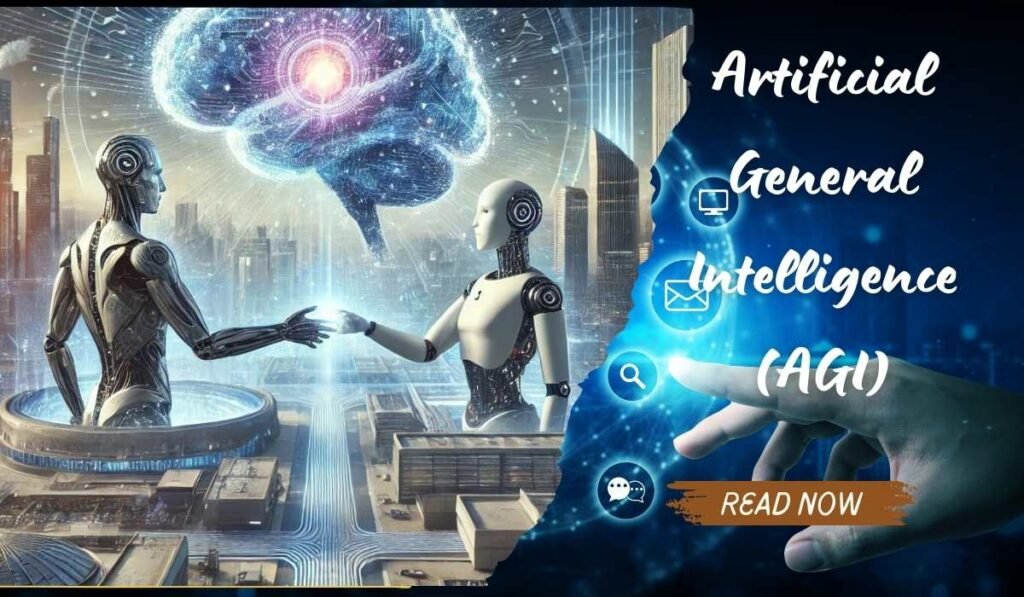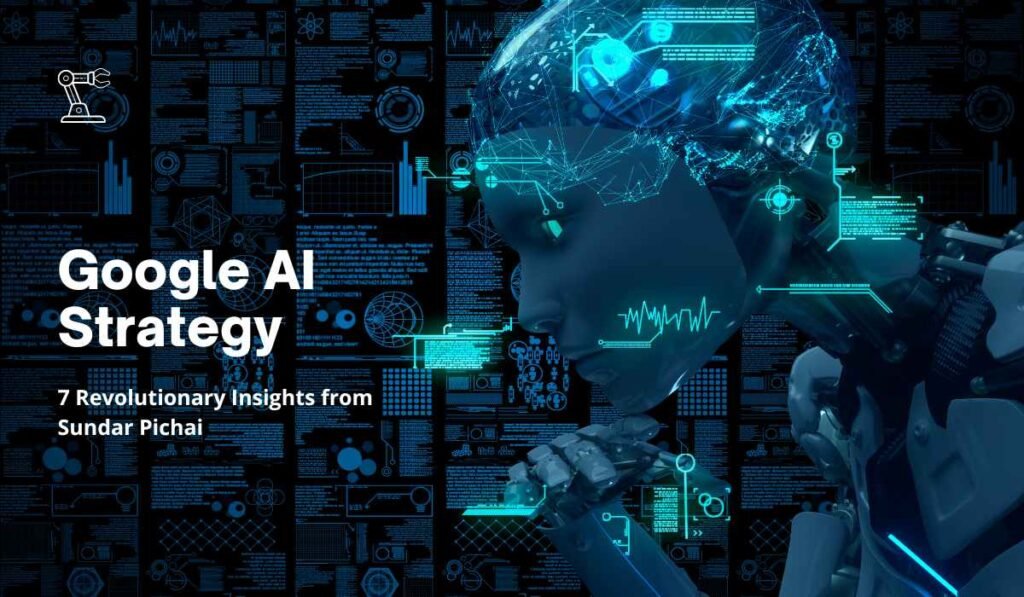In the rapidly evolving landscape of artificial intelligence, 2024 has emerged as a year of unprecedented AI breakthroughs. From humanoid robots challenging humans at ping pong to AI models generating hyper-realistic images, the boundaries between science fiction and reality are blurring faster than ever. Let’s dive into the most exciting developments that are reshaping our understanding of what’s possible in AI.
The Rise of the Machines: Humanoid Robots Take Center Stage
Figure 02: The Robot That’s More Than Meets the Eye
Imagine a robot that looks like it stepped out of a high-end car showroom. That’s Figure 02, the latest creation from Figure AI, backed by tech giants like OpenAI, NVIDIA, and Microsoft. This isn’t your average clunky bot – it’s a sleek, matte black marvel that’s pushing the boundaries of what robots can do:
- Superhuman Strength: Figure 02 can lift 25 kilograms (55 pounds), a significant upgrade from its predecessor.
- Dexterous Hands: With 16 degrees of freedom in its hands, it can manipulate objects almost as well as a human.
- AI-Powered Vision: Six onboard cameras and a sophisticated vision language model allow it to navigate its environment autonomously.
- Voice Interaction: Thanks to custom AI models developed with OpenAI, Figure 02 can understand and respond to voice commands.
But here’s the kicker – Figure 02 isn’t just showing off in a lab. It’s already hard at work in a BMW plant in South Carolina, proving that the future of manufacturing is here, now.
Google’s Ping Pong Pro: When AI Serves an Ace
While Figure 02 is busy on the factory floor, Google DeepMind’s latest robotic arm is making waves in the world of table tennis. This AI-powered player isn’t just hitting balls back and forth – it’s winning matches against human opponents:
- Impressive Win Rate: The robot won 13 out of 29 matches against players of varying skill levels.
- High-Tech Tracking: Using cameras to track the ball and a motion capture system to follow the human player’s movements, this robot brings a whole new meaning to “eye on the ball.”
While it might not be ready for the Olympics just yet (it still struggles with super-fast or tricky shots), it’s a testament to how far robotic dexterity and real-time decision-making have come.
The Global Robot Revolution
The world of humanoid robots is expanding rapidly, with innovations popping up across the globe:
- Unitree G1: This $16,000 Chinese robot stands 1.32 meters tall and can leap, twist, and dance like a pro.
- Boston Dynamics Atlas: Known for its parkour skills, Atlas is now pumping iron with push-ups and burpees.
- Agebot’s Robot Factory: Shanghai is set to open the world’s first humanoid robot factory, aiming to deliver 300 robots by the end of 2024.
- Astrobot S1: Launched by Stardust Intelligence, this jack-of-all-trades robot can iron your clothes and even cook you a stir-fry.
AI Gets a Language Upgrade: The New Conversationalists
OpenAI’s Project Strawberry: A Sweet Leap Forward
OpenAI is stirring up excitement with Project Strawberry, a language model that’s not just talk:
- Math Whiz: It can solve complex mathematical problems that would make most humans break a sweat.
- Marketing Maestro: Need a detailed marketing strategy? Strawberry’s got you covered.
- Real-Time Maven: It can pull up-to-the-minute information from social media platforms like X (formerly Twitter).
Early tests show Strawberry outperforming heavyweights like GPT-4 and Claude 3, setting a new bar for AI language models.
Google’s Gemini Live: Your AI Sidekick
Not to be outdone, Google has launched Gemini Live, bringing AI conversations to life:
- Voice Interaction: Have natural, flowing conversations with AI right on your smartphone.
- Emotional Intelligence: The AI can pick up on your tone and adjust its responses accordingly.
- Multitasking Marvel: Keep chatting even when your phone’s locked or the app’s in the background.
XAI’s Grok 2: The Rebel of AI
Elon Musk’s XAI has entered the chat with Grok 2, an AI that’s not afraid to push boundaries:
- Unrestricted Content: With minimal censorship, Grok 2 offers a more open-ended conversational experience.
- Benchmark Buster: It’s outperforming GPT-4 in areas like graduate-level science and math.
- X Factor: Direct access to real-time information from X keeps Grok 2’s knowledge cutting-edge.
Jamba Models: AI21 Labs’ Dynamic Duo
AI21 Labs has released Jamba 1.5 Mini and Jamba 1.5 Large, bringing new tricks to the AI language game:
- Hybrid Power: Combining transformer technology with structured state space models for improved performance.
- Long-Haul Champ: These models can handle extensive data sequences without breaking a sweat.
- Benchmark Beater: Outperforming competitors like Llama 3 and Mistral in various tests.
Agent Q: The AI Decision-Maker Extraordinaire
Developed by the AGI company and Stanford University researchers, Agent Q is changing the game when it comes to AI decision-making:
- Complex Problem Solver: Using Monte Carlo Tree Search and Direct Preference Optimization, Agent Q can tackle multi-step tasks with ease.
- Real-World Chops: In a test booking tables on OpenTable, Agent Q achieved a 95.4% success rate with online search capabilities – that’s better than most humans!
The AI Scientist: Automating the Path to Discovery
Sakana AI has introduced an AI system that’s not just assisting scientists – it’s becoming one:
- Full-Cycle Research: This AI can brainstorm ideas, run experiments, and write scientific papers autonomously.
- Peer Review Pro: A companion system can review AI-generated papers with human-level accuracy.
- Budget-Friendly: Producing a complete research paper for around $15, it’s revolutionizing the economics of scientific discovery.
Picture Perfect: The New Era of AI Image Generation
Flux: Photorealism at Your Fingertips
Black Forest Labs’ Flux is redefining what’s possible in AI image generation:
- Photorealistic Output: Images so lifelike, you might do a double-take.
- Open-Source Freedom: Developers can tinker with and integrate Flux into their projects.
- Versatile Versions: From the heavyweight Pro to the speedy Schnell, there’s a Flux for every need.
- Hardware Friendly: High-quality image generation without requiring a supercomputer.
While Flux is impressive, it’s not without its quirks. Text rendering and skin textures can sometimes be a bit off, reminding us that even in 2024, AI isn’t perfect.
Google’s Imogen 3: The Artist’s AI
Not to be left out of the image generation game, Google has released Imogen 3:
- High-Res Hero: Generating images at 1024×1024 pixels and upscaling them up to 8 times.
- Ethical Approach: Trained on a carefully curated dataset to reduce biases and improve quality.
- Competitive Edge: Outperforming rivals like DALL-E 3 and Midjourney V6 in human evaluations.
The Race to AGI: Building Tomorrow’s Superintelligence
The quest for Artificial General Intelligence (AGI) is heating up:
- Supercomputer Network: Scientists are creating a global network of supercomputers to accelerate AGI development, set to be fully operational by 2025.
- Bold Predictions: Industry leaders are making ambitious forecasts, with some suggesting human-level AI could be achieved as early as 2027.
The Ethical Tightrope: Navigating AI’s Challenges
With great power comes great responsibility, and these AI breakthroughs bring their share of concerns:
- Job Market Disruption: As robots and AI systems become more capable, what does this mean for human workers?
- Privacy Predicaments: With AI processing vast amounts of personal data, how do we protect individual privacy?
- Bias and Fairness: Ensuring AI systems make decisions free from prejudice remains a critical challenge.
- Regulatory Catch-Up: How can laws and regulations keep pace with rapidly advancing AI technology?
- Content Moderation Conundrum: The unrestricted nature of some AI models raises concerns about potential misuse.
- Financial Feasibility: The high costs of AI development pose challenges for long-term sustainability in the industry.
The Future is Now
The AI breakthroughs of 2024 are not just pushing boundaries – they’re redrawing the map of what’s possible. From robots that can challenge us in sports to AI systems that can conduct scientific research, we’re witnessing a transformation that will reshape industries, economies, and societies.
As we marvel at these advancements, we must also grapple with the ethical, social, and economic implications they bring. The future of AI is not just about technological progress; it’s about how we as a society choose to harness and direct these powerful tools.
What are your thoughts on these AI breakthroughs? Are you excited about the possibilities, or concerned about the potential risks? Share your views in the comments below and join the conversation about our AI-driven future!
Figure 02 is a humanoid robot developed by Figure AI, featuring superhuman strength to lift 25 kilograms, dexterous hands with 16 degrees of freedom, AI-powered vision with six onboard cameras, and voice interaction capabilities.
Google DeepMind's robotic arm has won 13 out of 29 matches against human players, showcasing impressive ball tracking and real-time decision-making capabilities.
Project Strawberry is a new language model by OpenAI that excels in solving complex mathematical problems, creating marketing strategies, and providing real-time information from social media, outperforming previous models like GPT-4.
Gemini Live enables natural, flowing conversations with AI, featuring emotional intelligence to adjust responses based on tone and the ability to multitask while the phone is locked.
Agent Q utilizes Monte Carlo Tree Search and Direct Preference Optimization to solve complex problems, achieving a 95.4% success rate in tasks like booking tables on OpenTable.
Sakana AI has developed a system that autonomously brainstorms ideas, runs experiments, and writes scientific papers, significantly reducing the cost of research.
Flux, developed by Black Forest Labs, produces photorealistic images, is open-source for developers, and offers various versions tailored to different performance needs.
Challenges include job market disruption, privacy concerns, bias in AI decision-making, regulatory issues, content moderation, and the financial sustainability of AI development.
Industry leaders predict that human-level AI could be achieved as early as 2027, supported by a global network of supercomputers set to be operational by 2025.
Humanoid robots like Figure 02 are already being deployed in manufacturing settings, demonstrating their potential to enhance productivity and efficiency in industrial processes.





